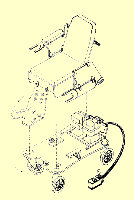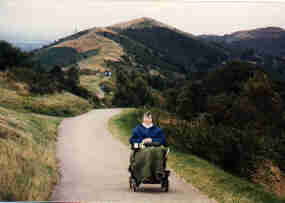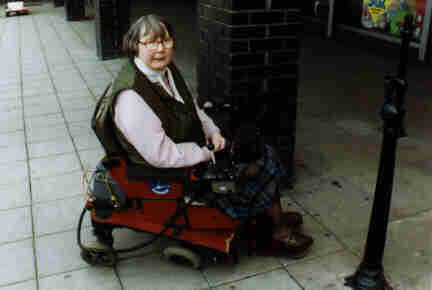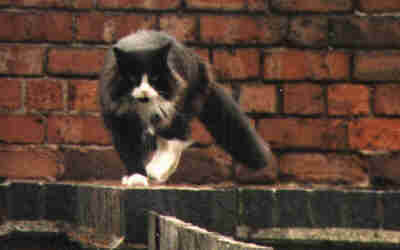 The squirrel is a
unique four wheel drive four wheel steer electric
wheelchair which, unlike other wheelchairs has a
body made out of wood. Sadly it is no longer
produced but I would like to say something about
what it has meant to me. The squirrel is a
unique four wheel drive four wheel steer electric
wheelchair which, unlike other wheelchairs has a
body made out of wood. Sadly it is no longer
produced but I would like to say something about
what it has meant to me.
In 1986 my first electric wheelchair finally bit
the dust after about two years of fairly intense
use, during which time it had tipped over
backwards, twice, lost one of its front wheels,
worn out numerous batteries and had a tyre
explode!. naturally the manufacturers who will
remain nameless blamed me for using the chair out
of doors when it was only intended for indoor use
(so why the picture on the brochure in the middle
of a public square?)
Anyway I was tending a stand at the Naidex
exhibition in Birmingham when I first saw the
squirrel. My son had seen it first the year
before and kept on at me to try it out, but I was
nervous of it because it looked so odd, compared
with what I was used to, so it was not until
after most people had gone that I tried it out.
 It was
actually comfortable, and that alone was enough
to interest me, so I arranged for a demonstration.
I actually gave it quite a tough test, I took it
up the Malverns. Sadly the batteries on the
original model were a bit on the small side, and
did not take me all the way to the top. It was
actually comfortable, and that alone was enough
to interest me, so I arranged for a demonstration.
I actually gave it quite a tough test, I took it
up the Malverns. Sadly the batteries on the
original model were a bit on the small side, and
did not take me all the way to the top.
Originally they were made by a factory in Bath
after a design which had been suggested by Lord
Snowden and worked on by Jeremy Fry. That
original company went broke, but was taken over
by another in Birmingham who did a conversion for
me with bigger batteries and a new computerised
controller.
By that time they had also come up with a newer
design altogether but I will tell you about that
when I come to write up part 2.
 Wherever
I went with my squirrel it attracted attention
and many people asked me if it was a home built
job as it did rather look like it had been made
in a woodwork shop,. However it took me
everywhere where I wanted it to. Up the long Mynd
in Shropshire, through muddy tracks and even half
way up a mountain in Scotland. I say half way up
because the batteries did start to fail on me and
it took a lot longer coming down with frequent
rests for the batteries to recover, however it
did make it back to the car under its own steam. Wherever
I went with my squirrel it attracted attention
and many people asked me if it was a home built
job as it did rather look like it had been made
in a woodwork shop,. However it took me
everywhere where I wanted it to. Up the long Mynd
in Shropshire, through muddy tracks and even half
way up a mountain in Scotland. I say half way up
because the batteries did start to fail on me and
it took a lot longer coming down with frequent
rests for the batteries to recover, however it
did make it back to the car under its own steam.
By this time the second company had gone broke
and a third had taken it over. They were part of
a large combine providing amongst other things,
complete mobile hospitals for the Arabian Gulf.
Sadly the gulf war brought an end to this company
and an end to the manufacture of the squirrel
wheelchair. I wrote to Michael Heseltine who if
you remember when he was President of the board
of trade promised to get up before breakfast if
necessary to save British Industry. He did not on
this one and allowed the companies debtors to
liquidate the stock which made it impossible to
gain spares.

Fortunately my chair continued to outlast the
company until one fateful day in 1993 when I
tried to guide it between two narrow Iron
Bollards which the Council had kindly put in
close to my home.
 I threatened to sue the Council,
whose insurers insisted that they had no
liability, but I was able to prove them wrong.
You see I had been involved in an earlier access
survey commissioned by them using the local
polytechnic, and they had produced a map which
backed me up So they had to pay out in full.
Serves them right. I threatened to sue the Council,
whose insurers insisted that they had no
liability, but I was able to prove them wrong.
You see I had been involved in an earlier access
survey commissioned by them using the local
polytechnic, and they had produced a map which
backed me up So they had to pay out in full.
Serves them right.
So was that the end of my Squirrel. Sadly for
that model, yes, but what did I go and do. I went
all the way to Leeds (petrol paid for by the
compensation) and bought another one second hand.
I will tell you what happened next in part II
|

 It was
actually comfortable, and that alone was enough
to interest me, so I arranged for a demonstration.
I actually gave it quite a tough test, I took it
up the Malverns. Sadly the batteries on the
original model were a bit on the small side, and
did not take me all the way to the top.
It was
actually comfortable, and that alone was enough
to interest me, so I arranged for a demonstration.
I actually gave it quite a tough test, I took it
up the Malverns. Sadly the batteries on the
original model were a bit on the small side, and
did not take me all the way to the top.  Wherever
I went with my squirrel it attracted attention
and many people asked me if it was a home built
job as it did rather look like it had been made
in a woodwork shop,. However it took me
everywhere where I wanted it to. Up the long Mynd
in Shropshire, through muddy tracks and even half
way up a mountain in Scotland. I say half way up
because the batteries did start to fail on me and
it took a lot longer coming down with frequent
rests for the batteries to recover, however it
did make it back to the car under its own steam.
Wherever
I went with my squirrel it attracted attention
and many people asked me if it was a home built
job as it did rather look like it had been made
in a woodwork shop,. However it took me
everywhere where I wanted it to. Up the long Mynd
in Shropshire, through muddy tracks and even half
way up a mountain in Scotland. I say half way up
because the batteries did start to fail on me and
it took a lot longer coming down with frequent
rests for the batteries to recover, however it
did make it back to the car under its own steam. 
 I threatened to sue the Council,
whose insurers insisted that they had no
liability, but I was able to prove them wrong.
You see I had been involved in an earlier access
survey commissioned by them using the local
polytechnic, and they had produced a map which
backed me up So they had to pay out in full.
Serves them right.
I threatened to sue the Council,
whose insurers insisted that they had no
liability, but I was able to prove them wrong.
You see I had been involved in an earlier access
survey commissioned by them using the local
polytechnic, and they had produced a map which
backed me up So they had to pay out in full.
Serves them right. 
